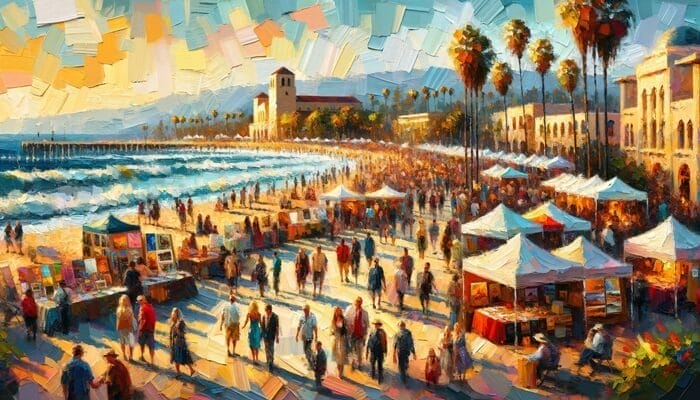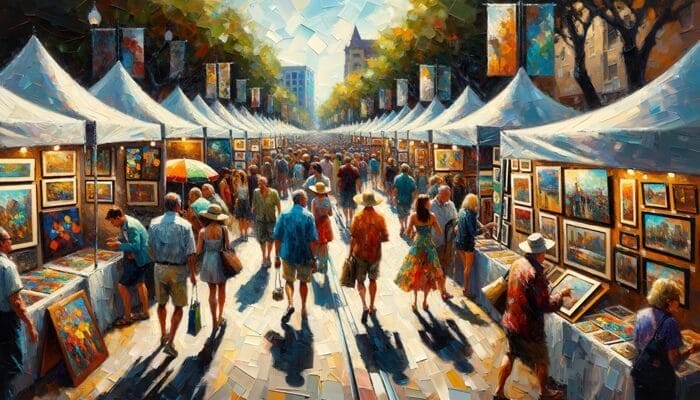Have you ever walked into an art gallery, encountered a captivating piece of art, and wondered what the artist was trying to convey? Or perhaps you’re an artist yourself, seeking to share your passion and vision with the world.
This is where an artist’s statement comes into play. It’s an essential part of presenting your work and establishing a connection with your audience. This post guides you in how to write an artist’s statement.

An artist’s statement is not just about giving the audience some insight into your work; it’s also about clarifying your own artistic intent and vision. By crafting a well-written statement, you can make sure your art is properly understood and appreciated.
Think of it as a bridge between you and your audience, helping them connect with your work on a deeper level.
In this post, we’ll walk you through everything you need to know to craft a compelling artist’s statement that showcases your unique creative voice. So, let’s dive in!
Artist Statements Example
This example demonstrates how an artist’s statement can concisely communicate the artist’s background, influences, philosophy, themes, techniques, and goals, while providing a clear and engaging overview of their artistic vision.
Jane Doe: Artist’s Statement
In a world dominated by digital screens, my art seeks to reconnect us with the beauty and simplicity of the natural world.
Growing up in rural New England, I developed a deep appreciation for nature’s quiet moments and the ever-changing colors and textures of the landscape. My art is heavily influenced by Impressionist painters such as Claude Monet and Vincent van Gogh, as well as my own experiences exploring the outdoors.
My artistic philosophy is rooted in capturing the essence of nature’s fleeting moments, drawing attention to the way light, shadow, and color interact to create a sense of tranquility and harmony. I explore themes of serenity, impermanence, and the interconnectedness of all living things.
Working primarily in oil on canvas, I employ a variety of techniques, from bold brushstrokes to subtle layering, to create depth and evoke emotion in my paintings. I often use a limited color palette to focus on the interplay of light and shadow, allowing the viewer to experience the scene’s atmosphere.
My goal as an artist is to inspire a renewed appreciation for the natural world and to encourage others to find solace in the beauty that surrounds us. Through my work, I hope to create a sense of connection between the viewer and the environment, fostering a deeper understanding of our place in the world.
Ultimately, my art serves as a reminder that, despite our fast-paced, technology-driven lives, the natural world continues to thrive and inspire, offering a wellspring of tranquility, resilience, and wonder.
Crafting the Perfect Artist’s Statement
You might be wondering, what exactly is an artist’s statement, and why do you need one? Well, an artist’s statement is a written description of your work, artistic philosophy, and creative process. It helps your audience understand your art and connects them with your vision. Think of it as a window into your creative world.
Definition and purpose
An artist’s statement serves several key purposes:
- It provides context for your work and helps the audience better understand and appreciate it.
- It allows you to communicate your artistic intent, vision, and creative process.
- It helps you establish a personal brand and distinguish yourself from other artists.
Components of an effective artist’s statement
A well-crafted artist’s statement should cover the following elements:
- Personal background and influences: Share your artistic journey, experiences, and the inspirations that have shaped your work. For example, Georgia O’Keeffe’s statement discusses her fascination with nature and her artistic beginnings.
- Artistic philosophy: Describe your creative beliefs, values, and the driving force behind your art. Ansel Adams’ statement is a great example of how he communicates his love for nature and the importance of conservation through his photography.
- Themes and subject matter: Explain the central themes, ideas, and messages present in your work. Artist Frida Kahlo’s statement discusses the importance of personal experiences and emotions in her art.
- Techniques and materials: Give an overview of the artistic methods, techniques, and materials you use in your work. Sculptor Alexander Calder’s statement touches on his innovative use of wire and kinetic sculpture.
- Goals and aspirations: Share your objectives, future plans, and what you hope to achieve through your art. This could include social change, personal growth, or artistic innovation.
Tips for Writing a Compelling Artist’s Statement

Now that you understand the purpose and components of an artist’s statement, let’s explore some practical tips to help you write one that truly stands out.
Be authentic and honest – Your artist’s statement should be a genuine reflection of who you are and what your art represents. Don’t try to mimic someone else’s style or adopt a persona that doesn’t feel true to you. Remember, your audience is interested in connecting with you and your unique artistic vision.
Use clear and concise language – Avoid using complex language, and instead opt for simple, straightforward words to describe your work. Your goal is to help your audience understand your art, not to confuse them with convoluted sentences.
Avoid jargon and overused buzzwords – It can be tempting to use industry-specific terms or trendy phrases to make your statement sound more sophisticated. However, this can alienate readers who aren’t familiar with the jargon. Stick to plain language that anyone can understand.
Provide context for your work – Help your audience better appreciate your art by offering some context. Explain the inspirations, cultural influences, or historical events that have shaped your work. For instance, in Kara Walker’s statement, she discusses the role of race, gender, and history in her art.
Write in the first person – Writing in the first person helps create a personal connection with your audience. It allows them to feel as if they’re having a conversation with you, rather than reading a formal document. This approach can be seen in Ai Weiwei’s statement, which conveys his passion and commitment to his art and activism.
By keeping these tips in mind, you’ll be well on your way to crafting a captivating artist’s statement that reflects your unique voice and resonates with your audience.
Is an Artist’s Statement the same as an Artistic Vision Statement?
No, an artist’s statement and an artistic vision statement are not the same. An artist’s statement describes the artist’s background, influences, and creative process, while an artistic vision statement focuses on the artist’s long-term goals, aspirations, and guiding principles for their work.
The Structure of an Artist’s Statement
A well-structured artist’s statement can make all the difference in how your audience perceives your work. Here, we’ll discuss the basic structure of an effective statement, complete with examples to guide you along the way.
Start your statement with a strong opening that piques the reader’s curiosity and sets the tone for the rest of the statement. You can begin with a powerful quote, a thought-provoking question, or an interesting anecdote that encapsulates your artistic essence.
In the body of your statement, delve deeper into the key components we discussed earlier in Section II:
- Personal background and influences
- Artistic philosophy
- Themes and subject matter
- Techniques and materials
- Goals and aspirations
Be sure to provide enough detail to give your audience a solid understanding of your work while avoiding excessive information that may overwhelm them. In Kehinde Wiley’s statement, he thoughtfully elaborates on his artistic inspirations and the cultural significance of his paintings.
End your statement with a powerful closing that reinforces your central message and leaves a lasting impression on your audience. This could be a call to action, a reflection on your journey as an artist, or a vision for the future.
By following this basic structure, you can create a compelling artist’s statement that not only informs your audience but also captivates them and invites them to explore your work further.
Tailoring Your Artist’s Statement for Different Situations
While it’s essential to have a solid, general artist’s statement, you may need to modify it depending on the context. Here are some common situations where tailoring your statement is necessary:
Gallery or exhibition statements
When exhibiting your work in a gallery, your statement should focus on the specific pieces being displayed and their thematic connections. This allows your audience to have a more profound understanding of the exhibition as a whole. For instance, in JR’s statement for his exhibition “MOMENTUM,” he discusses the underlying theme of the show and the specific works included.
Grant applications
When applying for grants or funding, your statement should emphasize how your art aligns with the mission and goals of the organization offering the grant. Additionally, you may need to discuss your financial needs and how the grant will help you achieve your artistic objectives.
Social media and online presence
Your online presence, including your website and social media platforms, is an essential part of your artistic brand. When crafting a statement for these platforms, keep it brief and engaging while still conveying your artistic vision. For example, street artist Shepard Fairey’s Instagram bio offers a succinct yet compelling glimpse into his work and philosophy.
Art competitions and residencies
When applying for art competitions or residencies, your statement should focus on the specific project or body of work you intend to create during the residency or for the competition. Be sure to address the unique requirements or themes of the opportunity.
By adapting your artist’s statement to suit different situations, you can effectively communicate your artistic vision and goals, increasing your chances of success in various professional opportunities.
Common Mistakes to Avoid

Writing an artist’s statement can be challenging, and it’s easy to fall into certain pitfalls. To ensure your statement is effective and engaging, here are some common mistakes to avoid:
- Being overly vague or generic – Your artist’s statement should convey your unique artistic vision, so avoid making broad, generic statements that could apply to any artist. Instead, focus on the specific aspects of your work that set you apart.
- Focusing too much on personal life details – While it’s essential to share some personal background, don’t let your statement become a chronicle of your life story. Keep the focus on your art and its themes, techniques, and influences.
- Overwhelming the reader with technical details – While it’s crucial to mention the techniques and materials you use, avoid overwhelming your audience with overly technical descriptions. Your goal is to engage the reader, not to turn your statement into a how-to manual.
- Ignoring grammar, spelling, and formatting – A well-written artist’s statement should be free of grammatical and spelling errors. Don’t forget to proofread your statement and ensure it’s properly formatted.
By avoiding these common mistakes, you can create a compelling artist’s statement that effectively communicates your artistic vision and engages your audience.

Final Thoughts
A well-crafted artist’s statement is more than just a description of your art; it’s a vital tool that helps you communicate your unique artistic vision to your audience. By investing time and effort into creating a compelling statement, you open the door to deeper understanding and appreciation of your work.
An effective artist’s statement not only showcases your work but also enhances your professional presence. It can make the difference between being accepted for a grant, residency, or exhibition, and missing out on these opportunities. By following the guidelines and tips provided in this guide, you can create a powerful statement that elevates your professional standing in the art world.
Engaging your audience and fostering meaningful connections
Ultimately, the goal of an artist’s statement is to engage your audience and foster meaningful connections with them. By crafting a captivating statement, you invite your audience to delve deeper into your work, explore its themes and techniques, and form lasting connections with you as an artist.
Artist’s Statement Template
[Your Name]: Artist’s Statement
Introduction
- Start with a powerful opening sentence or question that captures the essence of your work and engages the reader.
Personal Background and Influences
- Briefly share your background and the experiences that have shaped you as an artist.
- Discuss key influences, such as artists, movements, or personal experiences that have informed your work.
Artistic Philosophy
- Describe your artistic philosophy or guiding principles that drive your work.
Themes and Subject Matter
- Explain the central themes or subject matter explored in your work.
- Discuss any recurring motifs or symbols that are present in your art.
Techniques and Materials
- Describe the techniques and materials you use, as well as any unique or innovative approaches you take in your art.
Goals and Aspirations
- Share your goals as an artist, both short-term and long-term.
- Discuss the impact you hope your work has on your audience or society.
Conclusion
- End with a memorable closing statement that reinforces your central message and leaves a lasting impression on the reader.
Keep in mind that this is just a template, and you should feel free to customize it to suit your unique artistic vision and style. Remember to use clear and concise language, avoid jargon, and write in the first person.






